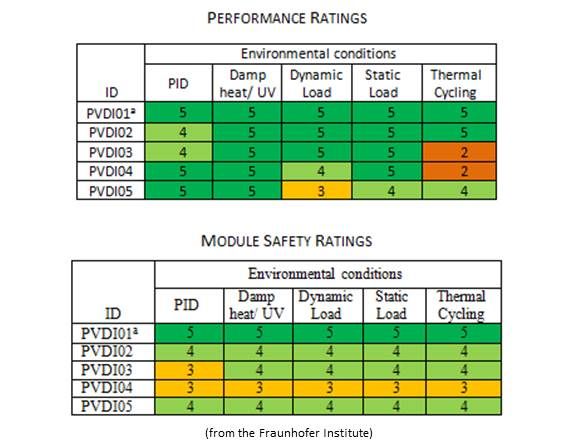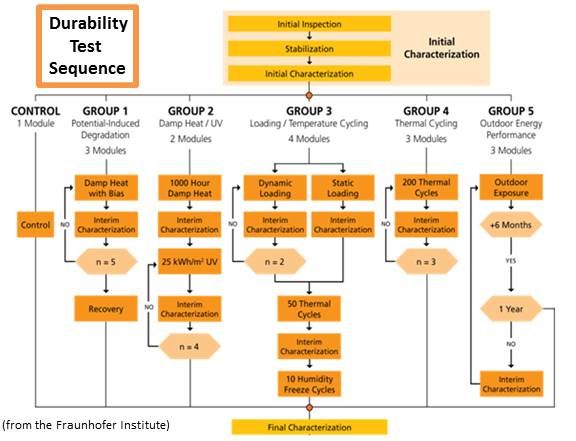One of the world’s most prestigious solar module testing labs just released its first panel durability report.
“The report provides solar PV financiers, developers, and other industry players with the first widely available quantitative dataset to assess long-term durability,” according to a statement from Germany’s Fraunhofer Institute for Solar Energy Systems (ISE) on the release of the first report from its Photovoltaic Durability Initiative (PVDI).
The PVDI protocol was designed to go beyond basic UL and IEC criteria in the evaluation of photovoltaic (PV) panels. It generated scores for modules of 0 to 5 from accelerated lab tests intended to simulate the stresses of real-world environments. Scores were given in five safety categories and five performance categories.
The SunPower (SPWR) E20 module was ranked first in the PVDI testing, garnering scores of 5 in all ten categories. (It's identified as module ID# PVDI01 in the table below.)
This first report covered tests of five of 2012’s top eight crystalline silicon (C-Si) PV modules. Those eight top-selling modules, according to Fraunhofer, were SunPower, Suntech (STP), Yingli (YGE), Trina (TSL), Canadian Solar (CSIQ), Sharp (SHCAY), Hanwha SolarOne (HSOL), and Kyocera (KYO).

The manufacturers of the other four module brands tested chose not to be identified.
The PVDI protocol covered advanced, rigorous safety and performance tests for potential-induced degradation (PID), damp heat and ultraviolet exposure, dynamic loading, static loading and thermal cycling.
The scores are expected to impact manufacturers' “reputation and marketing,” according to a Fraunhofer statement, as well as to “enable manufacturers with better durability to justify costs incurred in delivering higher-quality modules.” The scores can also be used by manufacturers to identify areas for additional work in their internal research and development, the statement added.

“A rule of thumb is that for every dollar it costs to catch a quality problem in the factory, it will cost you twenty times that if your customer catches it,” said David Meakin, Fraunhofer USA Center for Sustainable Energy Systems (CSE) senior technical staff member. The USA Center and Fraunhofer ISE have been collaborating on the PVDI since 2010.
The UL 1703 and IEC 61215 standards are, at best, tests of "infant mortality" and not long-term durability, Meakin explained in the GTM series on module testing. In assessing reliability, there are three basic failure periods, infant mortality, constant (or random) failure, and wear-out. “At the end of something’s life, because of wear-out, the probability of failure rapidly increases.”
The PVDI was developed in response to what Meakin called the unanswered question about PV modules: how long it takes until the probability of failure starts increasing.
A refined protocol and rankings from a second round of testing will be announced in early July at Intersolar North America. A third round is planned. “Results of the first round of tests have been used to inform the next round of tests,” according to Dr. Cordula Schmid of Fraunhofer's technical staff. “But continuity with the first two rounds has been largely maintained, to permit continuing comparison with prior test rounds.”
Though outdoor exposure of the modules is ongoing as an extension of the PVDI protocol, the report is based primarily on accelerated lab tests. "The correlation between the accelerated tests and operation in the field will be determined over time,” Schmid noted.
“Accelerated testing methods are part of it,” Meakin said. “But does a test for 1,000 hours relate to one year, ten years or 1,000 years? Depending on the material, it can be any one of these. We understand some of the acceleration coefficients, but not all of them. The other part is what we observe in modules that have been in the field for a long time. Sometimes we have to rely on accelerated testing because we don’t have twenty years to wait to see what happens.”



